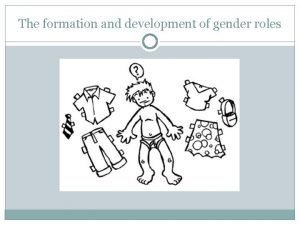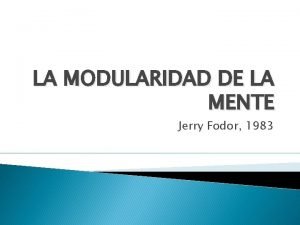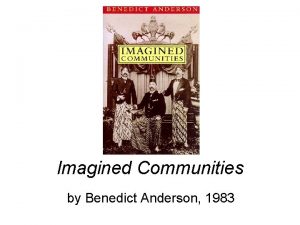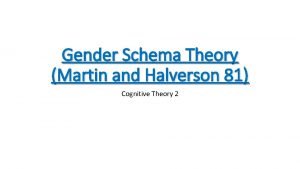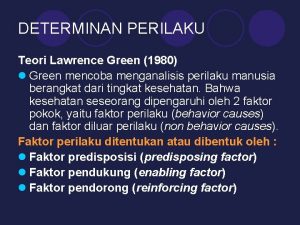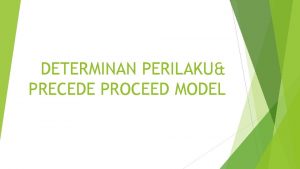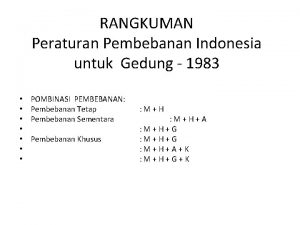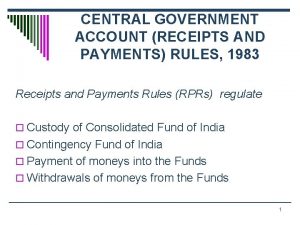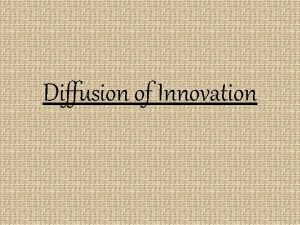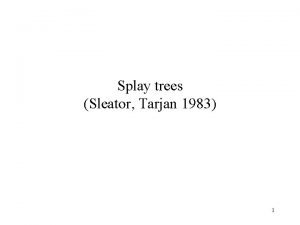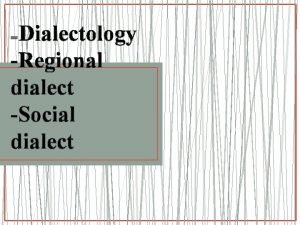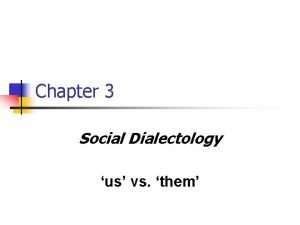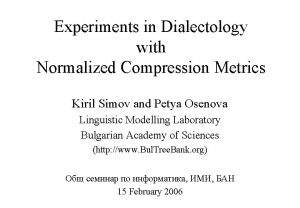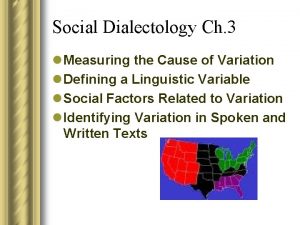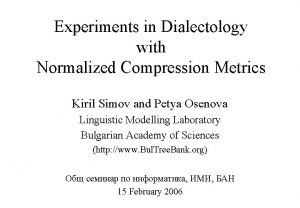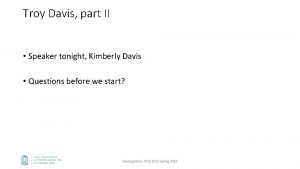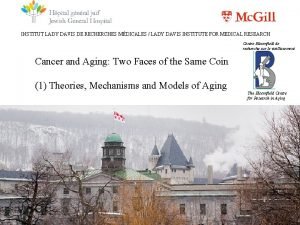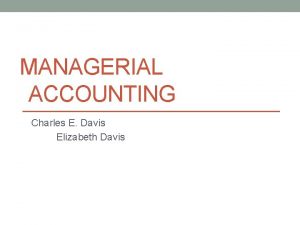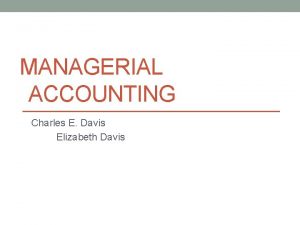Dialectology LM Davis 1983 English Dialectology An Introduction






















- Slides: 22

Dialectology LM Davis (1983) English Dialectology: An Introduction, University of Alabama Press JM Kirk, S Sanderson & JDA Widdowson (eds) Studies in Linguistic Geography, London: Croom Helm http: //www. llas. ac. uk/resources/goodpractice. aspx? resourceid=964 http: //en. wikipedia. org/wiki/Dialectology

Dialectology • • History of dialect studies Some well-known studies Methods of data collection Dialectometry 2

History of dialectology • Modern study of regional variation in language started around 1870 s, especially in Germanspeaking areas • Interest in both phonetics and lexis • Advances in practical phonetics made “measurement” of accent differences feasible • Grew somewhat as a response to prevailing view in historical linguistics – mainstream view that all sound changes were regular and exceptionless – dialectologists could show wide variety, and somewhat haphazard distribution 3

Georg Wenker (1876) • mailed a questionnaire with 38 short sentences to 1266 schoolmasters in the Rhine valley, asking them to “translate” them into local dialect • Extended survey to other parts of Germany over next few years: 44, 251 responses in total • Data quality very variable: informants were not trained 4

Jules Gilliéron (1897) • Atlas linguistique de la France • Used a fieldworker, Edmond Edmont, so phonetic data collected was consistently transcribed • Edmont was untrained (so not tainted by theory!) • Interviewed just 1 or 2 people in each of 639 localities, total 700 (of which only 60 female, age 15 -85) • Much bigger questionnaire: ~1500 items 5

Primitive methods • Reading out sentences – Not clear if the selection of data was carefully designed to elicit expected differences • Naming things – How do you say “head”? – What do you call this? (pointing to head) – Obvious risk of bias 6

Linguistic Atlas of New England • • Atlas projected begun 1929, headed by Hans Kurath first major study of English dialects focussed on NE for various practical reasons much more controlled method of data collection – demographics of informants strictly prescribed – age, education/occupation – lifelong inhabitants of the area and not widely travelled • fieldworkers also highly trained • conversational technique rather than direct questioning to elicit dialect words • 700 items of data elicited – lexical, phonological and grammatical 7

Survey of English Dialects • Early study of English dialects by Alexander Ellis (1889) – transcriptions of 970 words – ten dialect boundaries recognised • Joseph Wright (1905) English dialect dictionary – – more ambitious, but coverage patchy good coverage of Yorkshire good work on grammar well received – so well in fact that many felt there was no need for further study 8

Survey of English Dialects • suggested by John Orr, student of Gilliéron • work started 1947 by Eugen Dieth (Zurich) and Harold Orton (Sheffield, then Leeds) • completed by Orton after Dieth’s death in 1956 • published in parts 196271 • 1095 questions eliciting 1270 items – – 387 phonological 128 morphological 730 lexical 77 syntax • Nine topics – – – – – farmstead cultivation animals nature house and housekeeping human body numbers, time, weather social activities states, actions, relations 9

Types of questions in SED • Naming questions – What do you call a dog with half a dozen breeds in it? – What am I doing now? (mimes drinking) • Completing questions – If you drop a glass on the floor it might … – A man who can’t see at all is … • Converting questions – Base form: When I have an apple I eat it – Yesterday when I had an apple I … it – Whenever I’ve had an apple I’ve always … it • Talking questions – What can you make from milk? – What trees do you have around here? • Reverse questions – What’s the barn for, and where is it? – What do you mean by corn in these parts? 10

Other surveys • Too many to mention 11

Data collection • dialect surveys depend critically on collection of good data • relies on information gained first-hand from speakers of the dialects themselves: fieldwork is an essential part of the subject • time-consuming and fraught with difficulties • issues – how to 'enter' a community sensitively enough to gain the confidence of its members – how to find relevant people to study – how to persuade them to be part of the investigation, including being recorded – how to minimise the disruption caused to their lives by the data collection process – how to somehow recompense the community for its co-operation 12

What to sample • As already seen, historically dialect surveys have always been interested in variation in – lexis – phonology • Efforts made now also to sample variation in – morphology – syntax – …. 13

How to elicit data • Conversational method – very natural, but can be hit-and-miss • Direct elicitation – Need to be subtle about eliciting data – Avoid observer’s paradox – Especially, effects of imitation • Need to compromise – Try to be natural while asking unnatural things – eg What do you call this? (pointing to head) 14

Data analysis How are these lines on the map arrived at? The numbered dots represent individual informants Obviously, the data has to be collated source: H Orton & N Wright (1974) A word geography of England, London, Seminar Press reprinted in 15 LM Davis (1983) English Dialectology: An Introduction, University of Alabama Press

Data analysis • Dialect surveys provide maps such as these for each individual observation • So SED had hundreds or thousands of maps, each showing an individual result • Drawing the lines may be easy, but it doesn’t stop there 16

Pronunciation of /r/ in root (L) and rabbits (R) source: D Parry (1985) On producing a linguistic atlas: The survey of Anglo-Welsh dialects. In JM Kirk, S Sanderson & JDA Widdowson (eds) Studies in Linguistic Geography, London: Croom Helm, 51 -66 17

Dialectometry • Use of numerical classification methods to analyse and help to visualize the data • Involves application of mathematical classification models – clustering of similar data sets – done on computers – dialectologist runs the program by predicting what features might plausibly be grouped, or even determine relative weights of particular features 18

Dialectometry • Methods also allow dialectologists to quantify dialect differences, and hence measure language change • See J Nerbonne Introducing Computational Techniques in Dialectometry, Computers and the Humanities 37. 3, 2003, Pages 245 -255 19

Vocalisation of /l/ among older (L) and younger (R) speakers of Fenland English from D Britain (2005) Geolinguistics and Linguistic Diffusion. In U Ammon, N Dittmar, K Mattheier & P Trudgill (eds. ), Sociolinguistics: International Handbook of the Science of Language and Society. Berlin: Mouton De Gruyter. Found at http: //www. llas. ac. uk/resources/goodpractice. aspx? resourceid=964 20

Criticisms • Data collection methods do not reflect normal use of language • Single word answers hide – effects of continuous speech – possibility of variance in usage • Disproportionate number of “NORMans” as informants: non-mobile old rural men • Dialectology should include young people, women, living in cities 21

22
 Dialectology in linguistics
Dialectology in linguistics Brenda reimer
Brenda reimer Snehandu b. kar (1983)
Snehandu b. kar (1983) Pp 10 1983
Pp 10 1983 Selen soyder vikipedi
Selen soyder vikipedi Fodor 1983
Fodor 1983 Benedict anderson 1983
Benedict anderson 1983 Martin halverson
Martin halverson Diamond and dybvig 1983
Diamond and dybvig 1983 Teori perilaku lawrence green
Teori perilaku lawrence green Contoh penerapan model precede-proceed
Contoh penerapan model precede-proceed Peraturan pembebanan indonesia terbaru
Peraturan pembebanan indonesia terbaru Lawrence kohlberg's stages of moral development
Lawrence kohlberg's stages of moral development Central government accounts rules 1983
Central government accounts rules 1983 Dyna tac8000
Dyna tac8000 Modelo de van dijk
Modelo de van dijk Everett m. rogers (1983)
Everett m. rogers (1983) Bahagian pembangunan kurikulum kpm
Bahagian pembangunan kurikulum kpm Uu 6 1983
Uu 6 1983 1983 chile
1983 chile Brainstorm 1983
Brainstorm 1983 1983
1983 Tarjan 1983
Tarjan 1983

